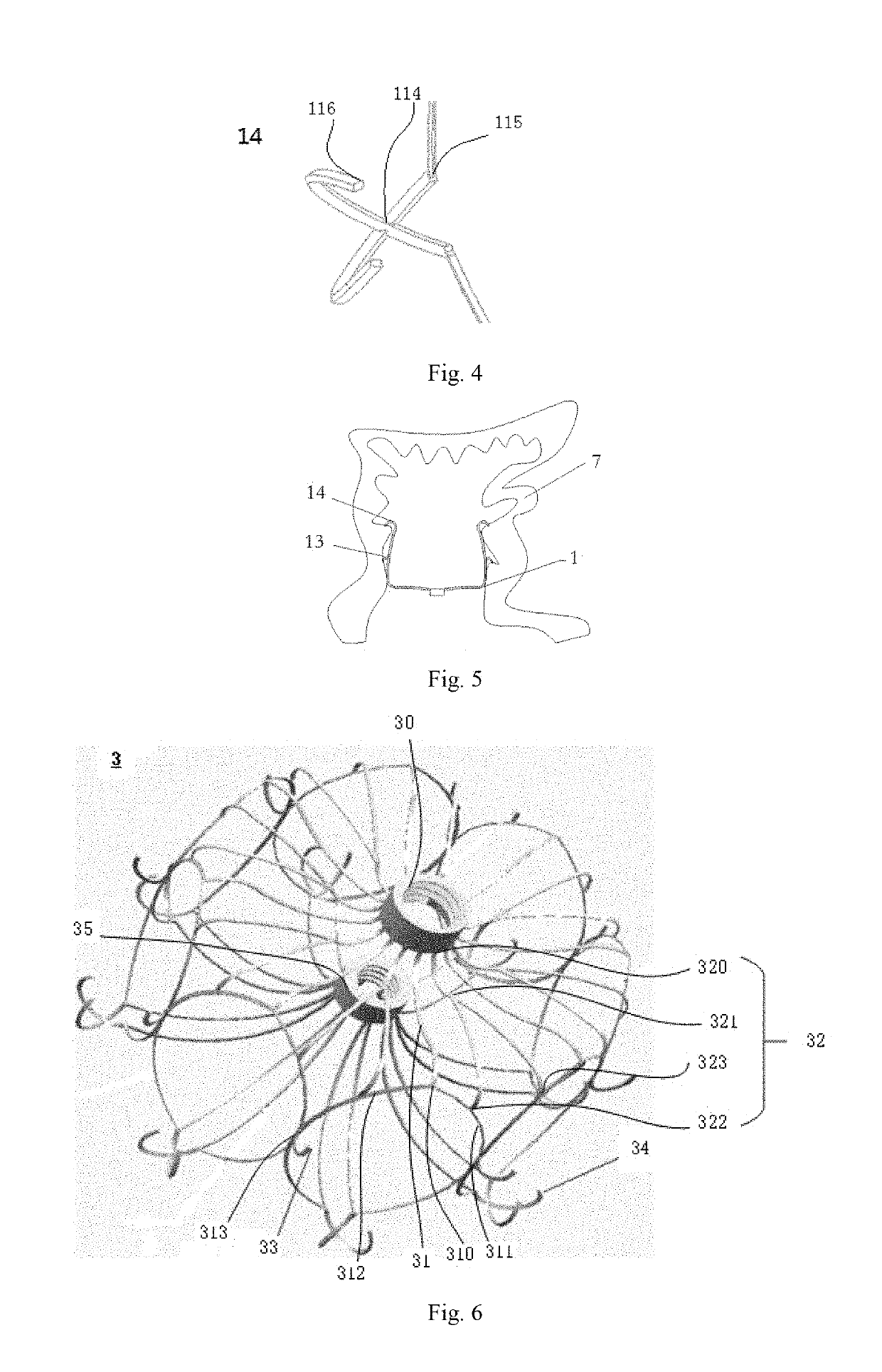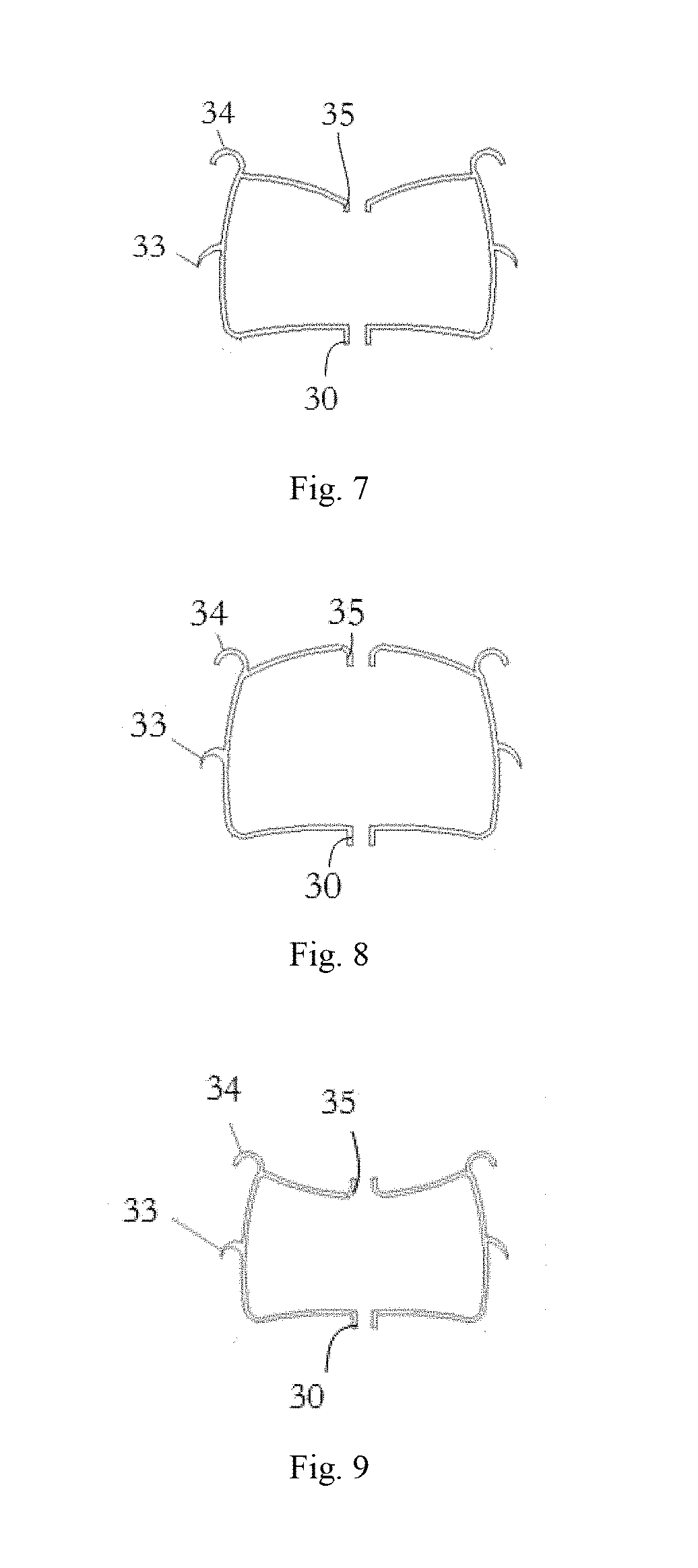Left atrial appendage closure and delivery system thereof
a technology of appendage and closure, applied in the field of medical devices, can solve the problems of significant increase in morbidity and mortality, lack of closure design, and inability to completely seal off the laa orifice, and achieve the effect of better loading or discharging
- Summary
- Abstract
- Description
- Claims
- Application Information
AI Technical Summary
Benefits of technology
Problems solved by technology
Method used
Image
Examples
embodiment 1
[0081]Reference is now made to FIGS. 1 to 3, in which FIG. 1 illustrates a perspective structural schematic view of a left atrial appendage (LAA) closure according to a first embodiment of the present invention, FIG. 2 illustrates a top schematic view of the LAA closure according to the first embodiment of the present invention, and FIG. 3 illustrates a partially enlarged schematic view of the LAA closure according to the first embodiment of the present invention. As shown in FIGS. 1 to 3, the LAA closure 1 includes a plurality of supporting struts 11. The supporting struts 11 are distributed around a first hub 10 and extend outwardly from the first hub 10. Each supporting strut 11 bifurcates at a first position 110 into a left branch 111 and a right branch 112. The left branch 111 of each supporting strut 11 is joined with the right branch 112 of an adjacent one of the supporting struts 11 at a second position 113. The branches further extend distally to form distal ends thereof. T...
embodiment 2
[0097]Reference is now made to FIGS. 6 and 7, in which FIG. 6 illustrates a perspective structural schematic view of an LAA closure according to a second embodiment of the present invention and FIG. 7 illustrates a cutaway schematic view of the LAA closure according to the second embodiment of the present invention. As shown in FIGS. 6 and 7, the LAA closure 3 includes a plurality of supporting struts 31. The supporting struts 31 are distributed around a first hub 30 and extend outwardly from the first hub 30. Each supporting strut 31 bifurcates at a first position 310 into a left branch 311 and a right branch 312. The left branch 311 of each supporting strut 31 is joined with the right branch 312 of an adjacent one of the supporting struts 31 at a second position 313. The branches further extend distally to form distal ends thereof. The LAA closure 3 further includes supporting rods 32 each interposed between corresponding adjacent two of the supporting struts 31.
[0098]Additionally...
embodiment 3
[0105]FIG. 10 is a perspective structural schematic view of an LAA closure according to a third embodiment of the present invention. As shown in FIG. 10, the LAA closure 4 includes a plurality of supporting struts 41. The supporting struts 41 are distributed around a first hub 40 and extend outwardly from the first hub 40. Each supporting strut 41 bifurcates at a first position 410 into a left branch 411 and a right branch 412. The left branch 411 of each supporting strut 41 is joined with the right branch 412 of an adjacent one of the supporting struts 41 at a second position 413. The branches further extend distally to form distal ends thereof. The LAA closure 4 further includes supporting rods 42 each interposed between corresponding adjacent two of the supporting struts 41. Extensions projecting inwardly from the distal ends terminate at a second hub 45.
[0106]In addition, each supporting rod 42 has a first end 420 connected to an outer side of the first hub 40. Each supporting r...
PUM
 Login to View More
Login to View More Abstract
Description
Claims
Application Information
 Login to View More
Login to View More - R&D
- Intellectual Property
- Life Sciences
- Materials
- Tech Scout
- Unparalleled Data Quality
- Higher Quality Content
- 60% Fewer Hallucinations
Browse by: Latest US Patents, China's latest patents, Technical Efficacy Thesaurus, Application Domain, Technology Topic, Popular Technical Reports.
© 2025 PatSnap. All rights reserved.Legal|Privacy policy|Modern Slavery Act Transparency Statement|Sitemap|About US| Contact US: help@patsnap.com



